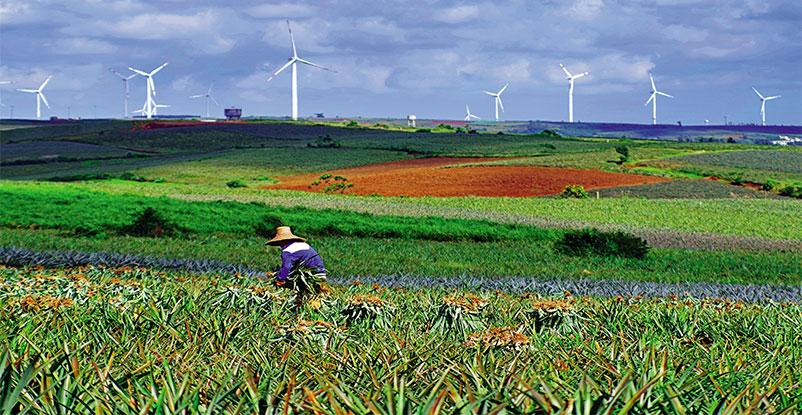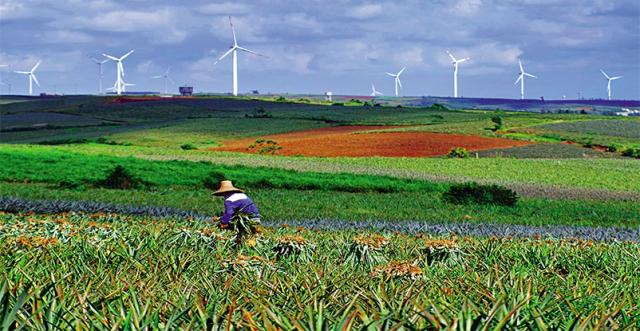n the 13th Five-Year Plan period (2016-2020), China made remarkable progress in reining in pollution and improving the environment, fulfilling its goals for air quality, water quality, carbon intensity and the emission of harmful gases. In 2020, for example, 337 cities at and above the prefecture-level enjoyed “goodquality” air for 87 percent of the period on average, a year-on-year growth of 5 percent. The average PM2.5 density decreased by 8.3 percent year-on- year to 33 micrograms per cubic meter, below the benchmark of 35 micrograms per cubic meter set by the World Health Organization.
Wang Jinnan, an academician of the Chinese Engineering Academy and head of the Chinese Academy for Environmental Planning under the Ministry of Ecology and Environment, noted that while China has made great progress in improving the environment in the past five years, there is a long way to go. In the annual legislative and political consultative sessions held in March, Wang, a deputy to the National People’s Congress, China’s top legislature, submitted a proposal suggesting establishing a law to promote carbon neutrality. In an interview with NewsChina, Wang shared his views on the challenges in environmental protection during the 14th Five-Year Plan period (2021-2025).
NewsChina: What’s your take on China’s achievements in environmental protection in the 13th Five-Year Plan (2016-2020)?
Wang Jinnan: In the last five years China exceeded all nine targets for the ecological environment and achieved remarkable success in curbing air, water and soil pollution. Meanwhile, environmental protection is guiding, optimizing and driving high-quality economic development. Between 2016 and 2020, the energy, industrial and transportation structures were optimized. During that time, carbon intensity (the amount of carbon emissions per unit of GDP) dropped by 19.5 percent, and the consumption of clean energy accounted for nearly one quarter of all energy consumed.
The institutions and mechanisms for environmental protection have also improved. In the five-year period, China became more involved in global environmental governance. For example, China fulfilled its carbon intensity commitments for 2020 ahead of schedule, and promised to peak carbon emissions by 2030 and achieve carbon neutrality by 2060.
NC: What problems should be addressed by the 14th Five-Year Plan (2021-2025)?
WJ: We still have a long way to go. The ecological environment has not profoundly improved yet, meaning there is a long way to go if we are to achieve the goal of building a “Beautiful China” by 2035. There are also rising uncertainties outside China, which bring risks and challenges for global environmental protection and improvement. Meanwhile, there is pressure due to the contradiction between environmental and economic development, and the fast pace of industrialization and urbanization is adding new pressures. Last but not least, there’s room for improvement in the modernization of environmental governance and global environmental governance.
In the future, China needs to make efforts in the following aspects. First, China needs to quicken the pace of promoting green, low-carbon development and the circular economy in the post-pandemic period. Second, pollution regulation and carbon reduction should begin at the source [of the pollution].
Systemic and holistic regulation could be achieved by using the goal [of air and water quality] to drive overall emissions reduction, reducing pollution at source and adjusting the industrial, energy, transportation and agricultural structure. We need to enhance the systematic protection and restoration of the environment. What’s more, pollution control should proceed in a scientific, targeted and legal way. For example, when we talk about the blue sky targets, it is important to be clear about the components of the pollution and find the sources before we formulate measures to mitigate it.
NC: Will there be differences in how China tackles pollution in the 14th Five-Year Plan?
WJ: The battle against pollution will be an updated version of the previous one. Pollution control and carbon reduction will be prioritized. The focus will transfer from end-of-pipe solutions to polluters and pollution at the source. This will need better economic structural adjustment and a push for green development to reduce the pollution at source to continually improve the environment.
The efforts will go deeper in improving air quality, reducing carbon, enhancing environmental protection, coordinating water resources, and so on. For example, China has committed to peak carbon emissions by 2030 and achieve carbon neutrality by 2060 and is making plans to achieve peak carbon emissions. In the 14th Five-Year Plan period, pilot zones for ecological conservation [set up in Jiangxi, Fujian and Guizhou provinces in 2016] and environmental protection [like some places in Zhejiang, Fujian and Jiangsu provinces] and pillar economic regions [including the Beijing-Tianjin-Hebei region, the Yangtze River Delta region and the Guangdong-Hong Kong-Macao Greater Bay Area] will be among the first to peak their carbon emissions.
Meanwhile, regulation will gradually spread from conventional environmental problems like air and water pollution and regular pollutants to wider fields, including handling global climate change, biodiversity protection, marine environment protection and so on. More emphasis will be placed on the control of new pollutants, human health and the function of ecological systems in serving humanity. The scope of governance will extend from cities to counties, towns and even rural areas.
NC: How can China achieve its goals of peaking carbon emissions and reaching carbon neutrality?
WJ: The core [strategy] is creating a new development pattern, using the goal of low carbon or even zero carbon to guide social and economic development, and realizing harmonized coordination between peak carbon emissions and carbon neutrality with high-quality development. To achieve this, China first needs to formulate a top-level design. China’s carbon emissions are equivalent to the total of the US and EU. There are only 30 years to reach carbon neutrality from peak carbon emissions, so that has a tighter schedule. It requires a top-level design and strong polices to push the job.
Besides, different places and sectors should be treated differently. In the first half of the year, the government needs to come up with a national action plan on how to peak carbon emissions. It needs to put forward a road map for different places to reach the goal in phases and clarify who is responsible for what, the deadlines and tasks in different regions and push different industries to achieve peak emission in stages.
Major industries including electricity, steel and cement should reach this goal as early as possible during the 14th Five-Year Plan period.
China needs to step up the adjustment of its energy structure and build a clean and low-carbon energy system. It can use the goal of carbon reduction to drive a revolution in energy and peak fossil fuel consumption, including coal, oil and gas gradually. It is urgent to publish a timetable to reach peak consumption for coal and oil, which I suggest should be achieved in the 14th and 15th Five-Year Plan periods respectively.
Last but not least, the market and the government have roles to play. The government needs to build appropriate carbon emission cap systems, fully develop the national-level carbon market and the emission allowances [permits to emit carbon] trading system, and put forward carbon tax policies to be included in an environmental protection tax. Meanwhile, to incentivize local governments to take responsibility, carbon emissions control [in different regions] should be included in the scope of central government environmental inspections (launched in 2016 and headed by ministerial-level officials) and integrated into the comprehensive assessment system of local leadership.
NC: There are only nine years to peak carbon emissions. However, some provinces are planning high-carbon projects for the 14th FiveYear Plan period. How can we strike a balance between economic and low-carbon development?
WJ: Many places believe they can still increase the use of fossil energy before 2030 and are even making plans in high-carbon sectors. They are considering reducing carbon emissions only after reaching the peak, unaware of how carbon neutrality goals will force the modes of development to change. This mindset will hinder achieving carbon neutrality.
On the one hand, China faces a tighter schedule to achieve carbon neutrality compared to developed countries. The EU reached peak carbon emissions of 4.5 billion tons in the 1990s while the US reached a peak of 5.9 billion tons in 2007. Carbon emissions in China are expected to climb to a maximum of 10.6 billion tons, which is 2.4 times that of the EU and 1.8 times that of the US. The EU plans to take 60 years to reach carbon neutrality from the peak. But China has only 30 years.
On the other hand, the life cycle of facilities in fossil-fuel electricity plants and steel mills is more than 30 years. If the facilities are put into use during the 14th Five-Year Plan, that means they will experience carbon lock-in until the middle of the century, which will dampen the hopes of reaching carbon neutrality by 2060. Or, these newly built facilities may be retired early for the goal of carbon neutrality, which will mean a huge waste of resources and may even impact the financial system or economy.
Therefore, to realize the goal of carbon neutrality we should change the thinking behind development right now and abandon the mode that is reliant on high-carbon projects. We can invest in low-carbon and green development projects that boast bigger development opportunities, get ahead of the game in the international trend of developing low-carbon technology and support more sustainable and healthier development.
NC: You plan to submit a proposal for a law to promote carbon neutrality. Why do we need a law?
WJ: In recent years, China has made great progress in establishing and amending laws so we can build an ecological civilization, particularly on pollution control and ecology protection. But there is no national law specially targeting climate change or low-carbon development. The legal system that supports carbon neutrality is weak and existing regulations are fragmented, and the system can’t meet the requirements in reality.
A law could enshrine the goal of reaching peak carbon emissions, give a legal status to control the total amount and intensity of emissions, clarify emission rights as legal property, ensure the orderly implementation of the carbon-trading market and provide a legal foundation for authorities to set emissions goals and carry out assessments to achieve those goals.

 Old Version
Old Version
